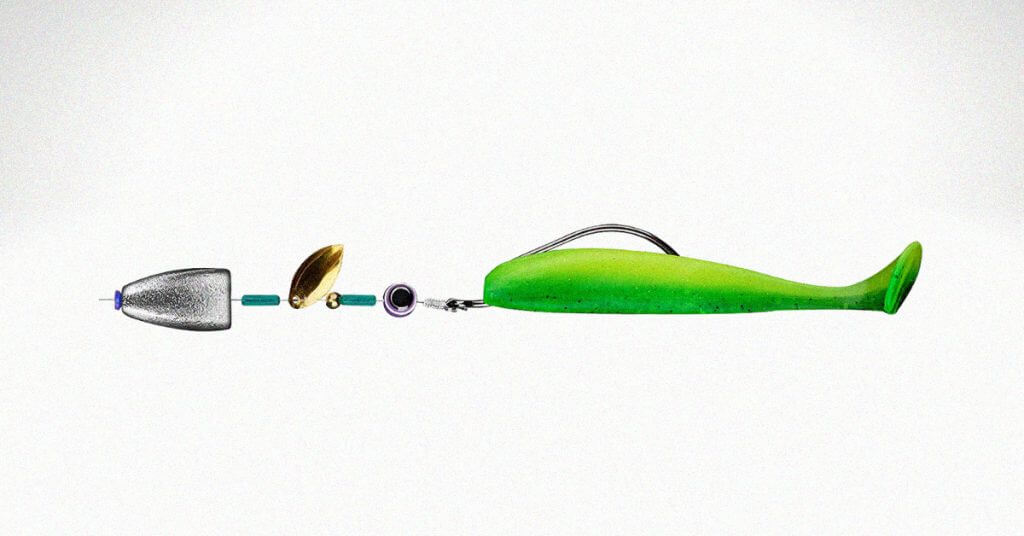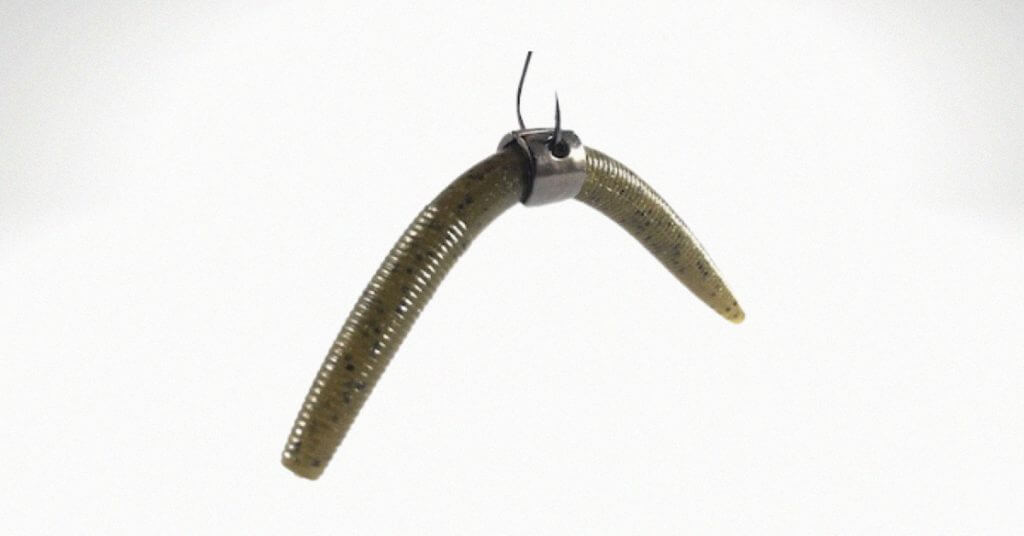Fish long enough, and you will hear about a Shaky Head jig and Texas Rig.
While there is not much debate among bass anglers regarding how each can catch bass, knowing when to go with one over the other can prove to be tricky.
Neither type of presentation is superior to the other, but each has environments where using one over the other will work better.
The following is a rundown of each type of fishing rig, a few scenarios where you may want to go with the shaky head vs Texas rig or vice versa, and some fishing tips to make the bait more effective.
Anglers.com Community Coordinator Wesley Littlefield shows us the differences between the Shaky Head and Texas Rig in this Youtube video.
What is a Shaky Head Rig?

The Shaky Head Jig is a small jig with a football-shaped, round, or flattened head attached to a small wire hook.
It is paired with a soft plastic bait and has multiple ways to finesse a bite out of bass when the fish are not attacking everything that moves.
A Shaky Head is used primarily in bass fishing to target largemouth and smallmouth bass, but its versatility makes it a good choice with multiple other fish species.
You can use the jig with a Senko or other soft plastic worms and creature baits resembling shad and other baitfish, crawfish, insects, and various worms.
Shaky Rig Setup
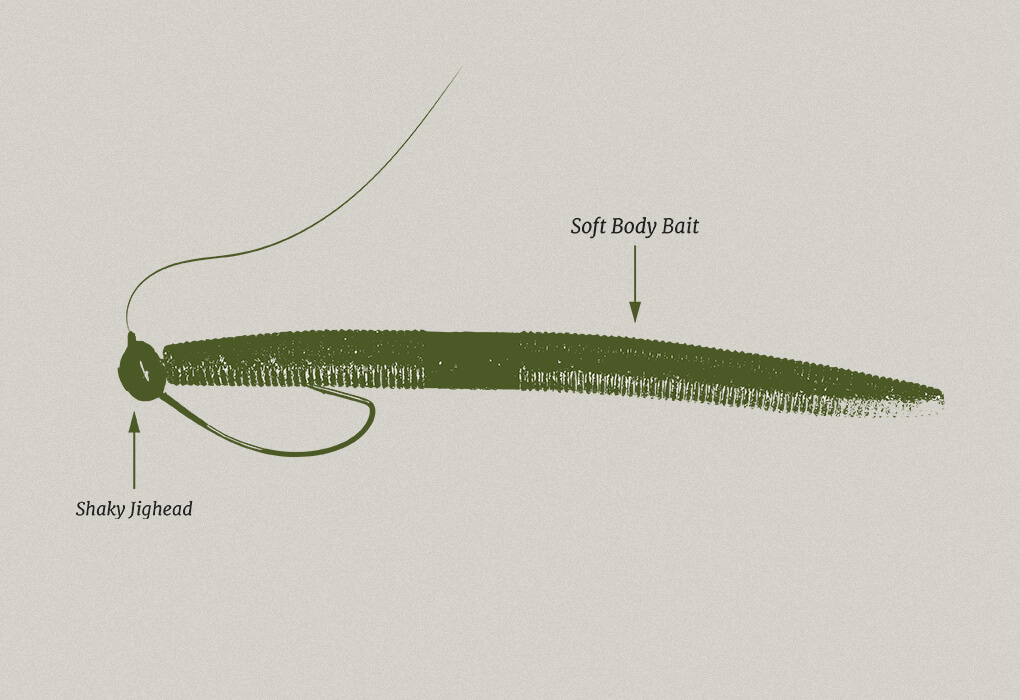
To set it up, put the corkscrew through the top of the bait, then push the hook through its belly so that the bait’s body is straight.
You do not want humps in the bait so that it has a natural action.
The key with this type of jig is to experiment and figure out what bass (or other fish species) will find alluring enough to attack.
When fishing a Shaky Head, anglers can use different presentations and approaches. Those include, but are not limited to:
Dragging It On The Bottom
Dragging the jig is exactly what it sounds like it is. You cast it, let it fall to the bottom, and pull it back. The bait sticks straight up in the water and does all the action.
The retrieval in this approach is very slow. The drag technique works best with a Senko for finesse worm or creature bait lures resembling aquatic life forms like a craw, salamanders, and insects.
Hopping It On The Bottom
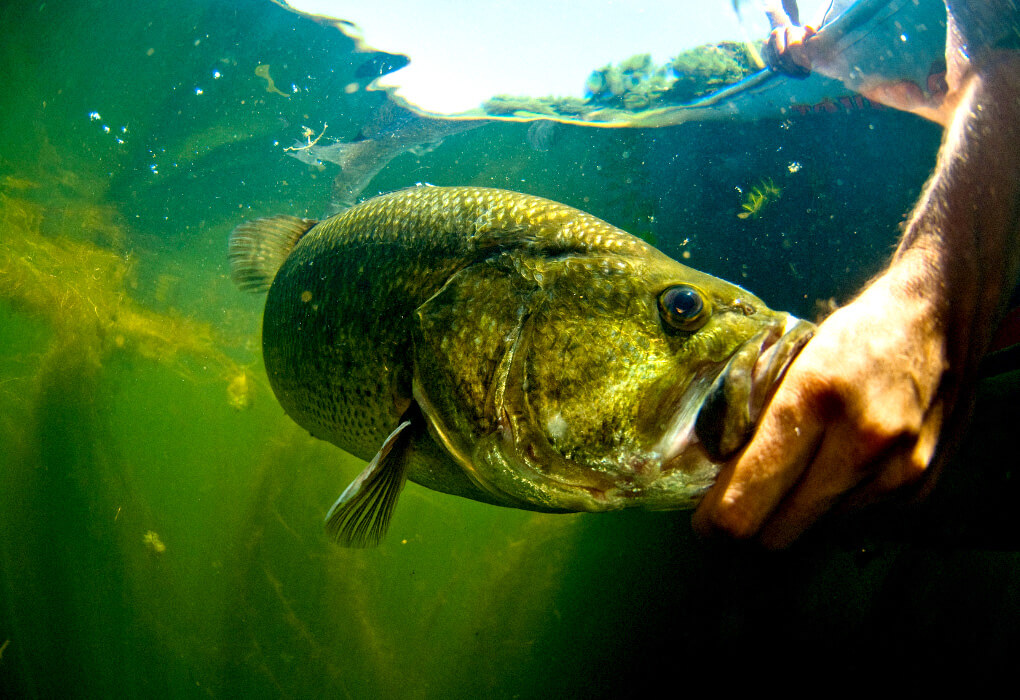
When you hop the jig head, you cast the bait and let it sit on the bottom. Slowly lift your rod tip about 14 inches and let the jig pull the line taught.
Repeat this until you retrieved the jig. Then repeat the process.
Dead Sticking
Dead Sticking the jig entails casting it, letting it sink, and bringing it back in exceptionally slowly. In frigid water, it is not uncommon to let it sit on the bottom without retrieving the jig for a minute or longer.
When you retrieve it, the goal is to move it only to attract attention, so the retrieval should only bring the jig in for one to two feet.
The inchworm bait works exceptionally well when dead sticking, as does a 4-inch stickbait.
Shaking
Shaking the jig entails casting it, letting it sink to the bottom, and then twitching the jig by slightly moving the rod tip.
This fishing approach aims to advance the Shaky Head worm very little and let the motion of the water do the rest. The shaking strategy is the utmost in finesse fishing.
Swimming It
Bringing in a Shaky Head with a steady retrieve or a process of retrieving and letting it sink before retrieving again, as you would with crankbaits, are also effective ways of fishing the jig.
Your goal is to keep the bait, often a trick worm, stickbait, or swimbait, just above the weed line.
Shaky Head Setup
If you’re a beginner to Shaky Head fishing, don’t miss this Anglers.com YouTube video showing you how to rig it!
I prefer to use a spinning reel and rod with a light line when fishing this type of jig.
Some anglers try to use a baitcasting reel for fishing a Shaky Head, but the point of the lure is to use as light a setup as possible.
The lightweight lure makes it very difficult to cast precisely using a baitcaster. You can do it if you take the time to tune the reel to the bait, but generally, a spinning rod works best.
The bait also works best in clear water when fish are not going after much or when the weather turns cold. The best strategy when fishing in the cold is to fish it slowly and then slow it down by half.
However, this rig will produce fish in any temperature water, so do not limit yourself.
Many anglers, myself included, consider the shaky head rig a “go-to” when the bite gets tough for most conditions.
What is a Texas Rig?
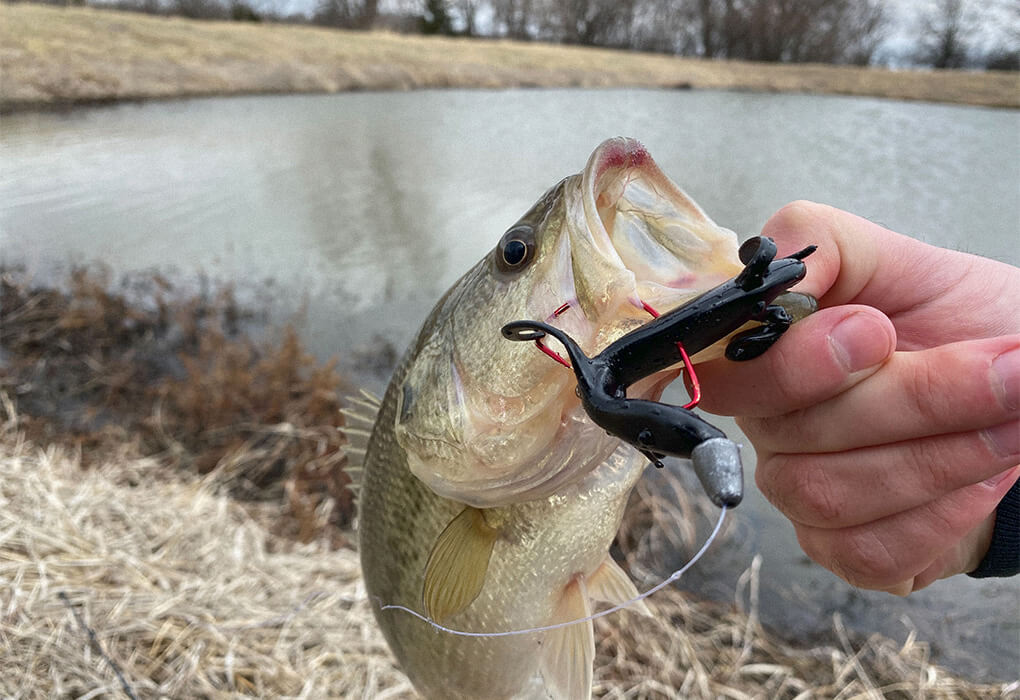
The Texas Rig catches everything from panfish and trout to big bass.
It is a highly versatile bait when used in the right conditions.
The “right conditions” include shallow or deep water, water with a current or no current, open water or around structure, clear or murky water, and everything in between.
One significant benefit of a Texas Rig is that it can be fished weedless, which lets you put the bait pretty much anywhere.
A Texas Rig is deadly in shallow water along weed lines, mainly when fished on a fluorocarbon line.
In deeper water or through heavy cover, when fished slow, with a steady raising and falling of the rod tip, reluctant bass can be enticed to bite a Texas rig.
Plastic worms, lizards, and creature baits are typically used with the Texas Rig, like five or 7-inch stickbaits or 7-inch curly tail worms.
The rig is weighted with a lead or tungsten bullet weight.
Texas Rig Setup
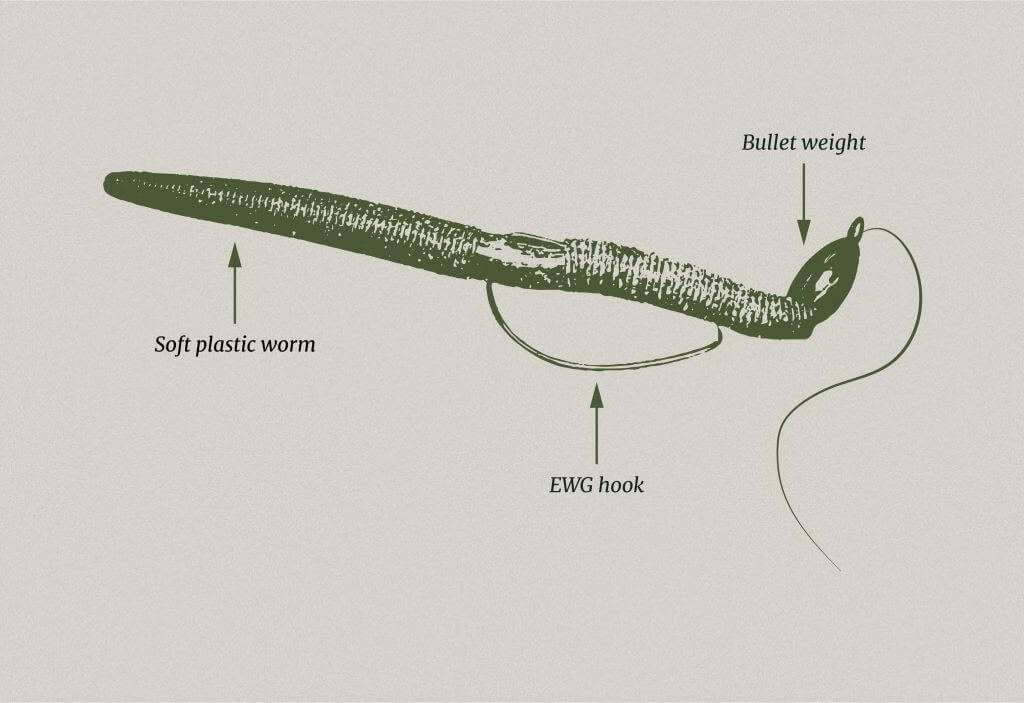
With a Texas Rig setup, a worm hook is pushed through the top of the head of the worm and pulled out about a quarter to a half inch down.
The weight slides up and down the line above the hook, unlike a Carolina Rig (which means you must put the sinker on the line first.)
The worm is then positioned on the angle of the hook so it lies flat.
Fish this rig along the bottom and by swimming it. The following approaches are the most effective.
Drag and Drop
Using the drag and drop method, lift the rod tip about a foot to two feet, pulling the weight and worm along the bottom. Lower the rod tip and pause.
The pause should depend on how active the bass are during that day.
The less active, the slower the retrieval works best. This process repeats until the bait is fully retrieved. It is then recast.
Hopping the Bait
This retrieve works best in warmer water when the temperature is in the feeding zone of the fish.
Hopping the bait with an erratic retrieve and pause approach will attract attention, and the movement of the bait will prompt the bass to strike.
Moderate Swimming
With a moderate swimming approach, the bait is cast and brought back as it falls into the water.
The retrieval gets paused to twitch the bait and let it sink. It is very similar to fishing a worm weightless, but the weight on the rig makes the bait quickly fall every time the retrieve pauses.
Bass will attack this bait as it falls, so it is crucial to keep the line taught when twitching it.
Shaky Head Vs. Texas Rig: Main Differences
The most significant differences are the weights and where the baits are set.
The Shaky Head Rig has a jig weight attached to the hook. The Texas Rig weight either moves up and down the line (bullet weight) or is connected to the line above the weight.
The soft plastic on a Shaky Head Rig is mostly straight on the jig right next to the weight. With a Texas Rig, it floats freely behind it.
Pros of the Shaky Head

- A Shaky Head works in open water and can be deadly when bass or other fish are not biting
- The rig also brings a lot of variety to the table in the sense of baits, ranging from worms to aquatic creatures to insects
- The rig is also very effective in cold water and can be left sitting on the bottom for a long time without sacrificing its position
Cons of the Shaky Head
- It struggles in exceptionally weedy areas and is not very effective in heavy cover
Pros of the Texas Rig
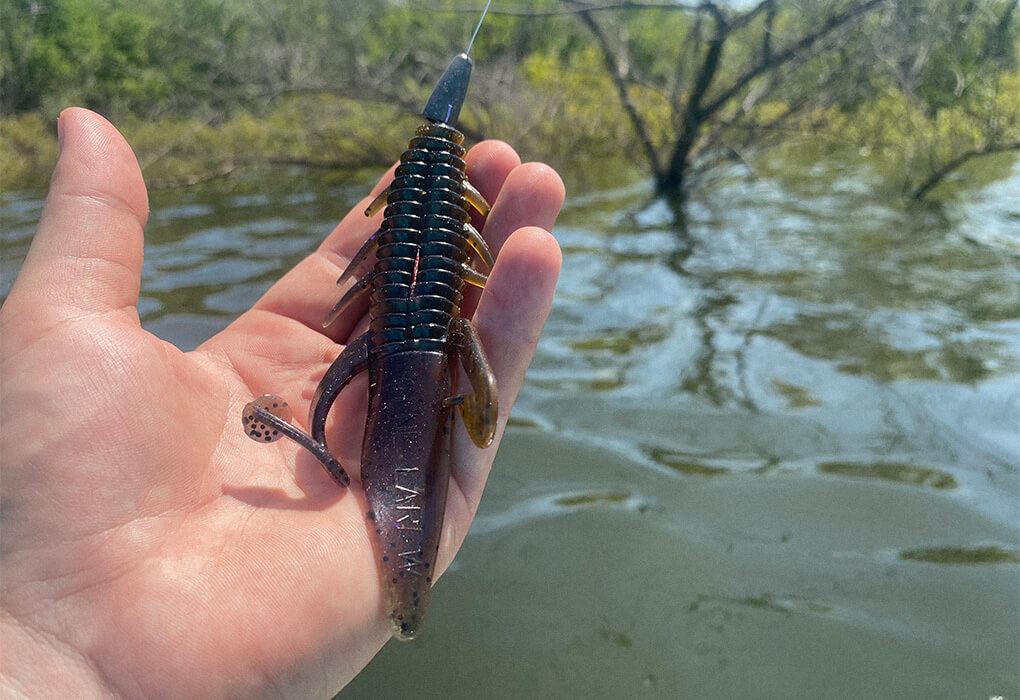
- A significant pro for the Texas Rig is that it is straightforward to fish. Beginners can pick it up in a very short period
- Another pro is that the weighted alignment can be modified to suit conditions. For instance, keeping the weight close to the bait in a current gives more control over the bait
- Probably the best pro for the rig is that bass love it
Cons of the Texas Rig
- The primary con is that the Texas rig is less effective than the Carolina rig in deeper water
Frequently Asked Questions
The following are some common questions anglers have regarding the shaky head vs texas rig.
Is the Texas Rig good for fishing?
Yes, the Texas Rig is good for fishing. In the right conditions, the Texas Rig can be deadly for bass. The key is getting the proper setup for your scenario.
Also, you must match the retrieval style to the activity of the bass. A fast retrieval works with hungry bass, while bass that are not biting should be fished more slowly.
What is “pegging” a Texas Rig?
Pegging a Texas Rig means attaching a bobber stop to the line and pinning the weight to the bait. The stop gives you much control over the bait’s action.
What lure is best for a Texas Rig?
It depends on the water fished and the activity of the fish. Popular baits are Senkos, creature baits, salamanders, and 6-inch plastic worms on a worm hook or straight shank hook.
What do you need to fish a Shaky Rig?
To fish a shaky rig you need a rod, spinning reel, light line (8 to 10-pound-test,) shaky jig head, and plastic bait to fish a shaky rig.
The plastic bait can range from a shorter plastic worm to crayfish, bugs, and salamanders.
What is a weedless Shaky Head?
A weedless shaky head is a standup or round head with a wire that attaches at the head or just below it and extends to the hook’s point to prevent it from getting snagged.
A weedless rig is more than just weedless. It can be drug through weeds and over rocks or through moderately thick cover, including through grass or light lilies.
Can you rig worms on a Shaky Head?
Yes, you can rig worms on a shaky head. The typical worm used is about 2 to 6 inches, but you can use trick worms and regular plastic worms.
The difference is that the longer the worm, the less effective the jig head is in holding the bait vertically in the water on the bottom of where you are fishing.
Last Cast
There is no doubt about the effectiveness of a Shaky Head or Texas Rig setup. When used in the right fishing environment, either is a slayer of bass.
The Shaky Head is excellent for prompting reluctant bass to bite. The Texas Rig can be used in just about any type of fishing, including saltwater.
Regardless of how you use the shaky head vs Texas rig, either should be a “go-to” bait that every bass angler needs to have as part of their tackle, no matter where they fish.
I’d love to read your best shaky head and Texas rig tips in the comment section below!


